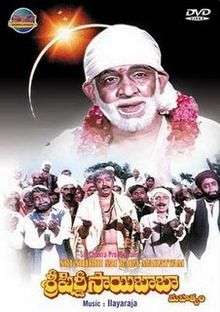Sri Shirdi Saibaba Mahathyam
Sri Shirdi Saibaba Mahathyam is a 1986 Telugu musical hagiographical film written and directed by K. Vasu, based on the life of Shirdi Sai Baba, who has preached and practiced Religious humanism.[1] Vijayachander portrayed the role of Baba. The film was a blockbuster and remained a cult classic.[2][3] The film ran for 175 days in 12 centers, was screened at the International Film Festival of India and the Moscow Film Festival.[3] The soundtrack was composed by Maestro Ilaiyaraaja, with lyrics written by Acharya Aatreya, and received wide appreciation. The film was dubbed into Hindi as Shirdi Sai Baba Ki Kahani and into Tamil as Sri Shirdi Saibaba.[3]
| Sri Shirdi Saibaba Mahathyam | |
|---|---|
 | |
| Directed by | K. Vasu |
| Produced by | Gogineni Prasad K. Babu Rao |
| Written by | Madhu Kumar |
| Screenplay by | K. Vasu |
| Story by | Sai Chakra Unit Robin Charles Vijaya Rathnam |
| Starring | Vijayachander Chandra Mohan J. V. Somayajulu Anjali Devi |
| Music by | Ilaiyaraaja |
| Cinematography | V. Jayaram |
| Edited by | Nayani Maheswara Rao |
Production company | Saradhi Studios |
| Distributed by | Sai Chakra Productions |
Release date | 1986 |
| Country | India |
| Language | Telugu |
Plot
Sadguru Sai Baba of Shirdi lived in British India. He was initially shunned by both Hindus and Muslims, especially by Hindu Bal Bhate. Sai was a Muslim and Bal Bhate forbade him to enter any Temple. Rohila, a Muslim, who thought Sai was desecrating the local Masjid by performing Hindu prayers and incantations, attempted to kill Sai. Then he saw both the Allah and Bhagwan in Sai and became a devotee. When Sai was ready to give up his body and resurrect himself after 3 days, just like Lord Jesus, a disbelieving Bal had wanted Sai's body to be cremated within 24 hours - only to find out that Sai had indeed risen, and also became his devotee.
Bhagoti, a leper, who was cured by Sai became his follower. Though Sai had no relations, he did call Tatya's mother his sister; Tatya his maternal nephew; a devotee named Laxmi as his daughter, and an elderly woman as his mother. Sai displayed his true form and opulence to another devotee, Nana Chandorkar. Sai lived in a rebuilt Masjid and urged his devotees to pray to God, as the Creator and to love and respect all living beings. He begged for alms daily so that he could collect sins and wash them away.
He always uttered "Allah Bhala Kare" and "Bhagwan Bhala Kare" to both Muslims and Hindus alike. He appeared in a multitude forms to his devotees (Lord Jesus, Guru Nanak Devji, Allah, Bhagwan Shri Ganesh) to cater to the various tastes of devotees. Sai was also fond of Nanavli, a mentally challenged devotee, who often challenged Sai. He was one of the few who really understood and accepted Sai as Vishnu's Avatar. Sai appeared simultaneously in a wealthy man's and Nana's dreams and called upon them to construct a Mandir of Bhagwan Shri Krishna. While the construction was under way, Sai prophesied the death of Tatya. Shortly thereafter while bequeathing the nine coins symbolizing nine virtues to Laxmi (which depict Sravan, Kirtan, Smaran, Padaseva, Archana, Namaskar, Dastan, Samveta and Atmanivrdan) Sai was ready to demonstrate to his devotees why they should not worry about Tatya's impending demise.
Cast
- Vijayachander as Shirdi Sai Baba
- Chandra Mohan as Nanavali
- Kanta Rao as Shyama
- Seshagiri Rao as Mahalsapathi
- Anjali Devi as Baayeeja Bai
- Sarath Babu as Chand Patel
- J. V. Somayajulu as Nana Chandorkar
- Ramakrishna as Aayaram
- Chalam as Gayaram
- Suthi Veerabhadra Rao as Bal Bhate
- Tyagaraaju as Daroga Dasuganu
- Adabala as Bhagoti
- Jaya Bhaskar as Ramachandra Patil
- Raja as Tatya Patil
- Murali Mohan
- Ramaprabha
- Rushyendramani
- Sridhar
- Vijaya Chamadeswari
Soundtrack
- Baba Sai Baba Neevu Maavale Manishivani (Music director: Ilayaraja; Singer: S. P. Balasubrahmanyam)
- Daivam Manava Roopamlo Avatarinchunee Lokamlo (Music director: Ilayaraja; Singer: P. Suseela)
- Hey Panduranga Hey Pandarinadha Saranam (Music director: Ilayaraja; Singer: Yesudas)
- Jai Shirdi Naadha Saideva (Dandakam) (Music director: Ilayaraja; Singer: V. Ramakrishna)
- Maa Paapala Tolaginchu Deepala Neeve Veliginchinavayya (Music director: Ilayaraja; Singer: Yesudas)
- Nuvvu Leka Anadhalam Bratukanta Ayomayam Baba (Music director: Ilayaraja; Singer: S. P. Balasubramanyam and Chorus)
- Slokams (Music director: Ilayaraja; Singer: Yesudas)
References
- Ashish Rajadhyaksha; Paul Willemen (10 July 2014). Encyclopedia of Indian Cinema. Routledge. p. 108. ISBN 978-1-135-94318-9.
- "Sri Shirdi Saibaba Mahathyam". 1 January 2000 – via IMDb.
- Rajadhyaksha, Ashish; Willemen, Paul (10 July 2014). "Encyclopedia of Indian Cinema". Routledge – via Google Books.